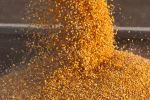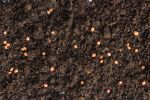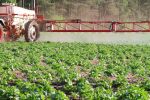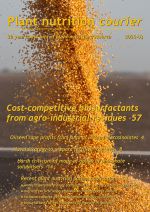-
Plant nutrition courier | August 2025
This email newsletter is the notification of the just published Plant nutrition courier 2025-03 issue.
Subscribers received this issue on 05-08-2025.
 Cost-competitive biosurfactants from agro-industrial residues
Cost-competitive biosurfactants from agro-industrial residues
Copper oxychloride is poorly soluble in water. The same applies to copper oxide and zinc oxide. Biosurfactant extracts from corn steep liquor can improve both the solubility and suspensibility of these salts. Spanish chemical engineers are exploring this residual stream as a source of cost-competitive adjuvants and formulation inerts. And recently other agri-food residual streams have also come into focus.
This issue of the Plant nutrition courier has six extra pages of news and insights into formulation research.
Click here for the full issue
Other formulation research news:
• Solid state encapsulation of active ingredients
• Melt suspension technique for low-melting active ingredients
• Some amine-based formulation inerts are a significant source of carcinogenic nitrosamine precursors
• Low risk of viroid spread with oils from citrus fruit peels
• Generation of surfactant-free oil-in-water nanoemulsions using nanopore membrane and ultrasound
• Assessing the viscosity inside oil droplets in nanoemulsions
 Oilseed rape profits from sulphur in seed glucosinolates
Oilseed rape profits from sulphur in seed glucosinolates
Glucosinolates are antinutritional factors in oilseed rape meal used for animal feed. However, recent research shows that these sulphur-containing molecules do matter for seedlings growing on soils low in this plant nutrient.
Click here for the full issue
Other arable news:
• Adequate spring nitrogen supply is sufficient for winter barley production
• Spraying potassium against heat stress in wheat
• Molybdenum favours nitrate uptake by maize
• Winter wheat canopy absorbs ammonia emitted from soil surface
• Ammonium stimulates uptake of soil-applied selenium in maize
• Steel slag silicate fertiliser suppresses grain cracking in brewer’s rice
• Maize en sugar beet benefit differently from preceding cover crops

 Novel strategy to prepare fertiliser coatings
Novel strategy to prepare fertiliser coatings
Tannic acid and other phenolic ligands can control the dissolution rate of urea. Such ligands can also be combined with metal ions to form so-called metal–phenolic networks, which can be used to encapsulate urea. Australian scientists used a one-step, solvent-free mechanochemical method to prepare a novel slow-release urea fertiliser.
Click here for the full issue
Other fertiliser news:
• Urea synthesis by ball milling ammonia water and carbon dioxide
• Mechanochemical synthesis of slow-release molybdenum-zinc fertilisers
• Slow-release molybdenum fertiliser
• Potassium tripolyphosphate suited as fertiliser
• Brushite is suitable as a phosphate fertiliser
• Siderophore-based zinc chelate
 Machine learning used to improve interpretation of nutrient levels in leaf samples
Machine learning used to improve interpretation of nutrient levels in leaf samples
Machine learning can help to improve the interpretation of measured nutrient levels in leaf samples of horticultural crops. Recent research indicates that machine learning algorithms can offer a more accurate way to interpret nutrient data compared to human interpretation of tissue tests.
Click here for the full issue
 Horticultural nutrition news
Horticultural nutrition news
• Spinach benefits from combination of boron and boron-complexing metabolites
• Preharvest boron spraying limits frost impact on broccoli quality
• Seed priming to enhance iodine content of tomato
• A little iodine increases lettuce yield
Click here for the full issue
 Harsh criticism of mode of action of phosphate solubilisers
Harsh criticism of mode of action of phosphate solubilisers
Soil has no precipitated phosphate to solubilise. Hence, so-called phosphate solubilising microorganisms should have other ‘modes of action’ by which they may improve a crop’s phosphorus status, according to an Australian soil scientist.
Click here for the full issue

 Patent applications: novel copper formulation for spray application
Patent applications: novel copper formulation for spray application
French formulators have developed a water dispersible granule formulation for sparingly water-soluble and insoluble copper salts. The choice of solvents and other formulation inerts contributes to the improved performance of the formulation. Copper is both an agrochemical active ingredient and a micronutrient. The formulation has been developed with use as a fungicide/bactericide in mind.
Click here for the full issue
Editor's pick of just published patent applications:
• Inclusion complex increases thermal stability of urease and nitrification inhibitors
• Use of polyphosphate to reduce caking of ammonium orthophosphate fertilisers
• New method to produce iron(II) gluconate in liquid or solid form
• Pyrazole derivatives that inhibit both urea hydrolysis and nitrification
• Aqueous urea fertiliser
• Extraction process for uranium, heavy metals and rare earths from phosphate sources
• Phosphate production process for phosphate sources with relatively high minor element ratio
• Biodegradable chitosan-based fertiliser coating with deep eutectic mixture plasticizer
• Suspo-emulsion containing micronutrient particles as a biodegradable fertiliser coating
• Biosurfactants as wetting agents to improve irrigation
 Single issue
Single issue
Click here for a single issue of the Plant nutrition courier.
Information about Plant nutrition courier
Free issue (Extra thick 2024-02 issue, 2.59 Mb)Subscription packages
Plant nutrition courier
Please let us know if you are not interested in news about plant nutrition.